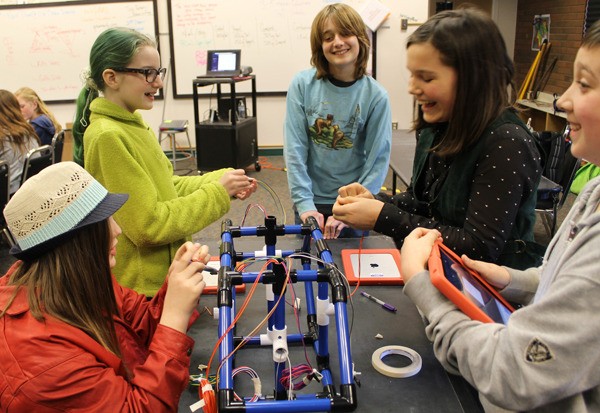On a recent Wednesday afternoon, a dozen or so brightly clad South Whidbey Academy middle schoolers buzzed about on one side of Timmie Sinclair’s “bat cave” chattering, problem-solving, labeling and affixing. On the opposite end of the classroom, a group of nine high schoolers clad in black Robotics Anonymous T-shirts concentrated a similar, though somewhat more complex, project.
The students are all a part of South Whidbey Academy’s Underwater Robotics Program. Students who have completed the middle school level robotics class may apply to be a part of Robotics Anonymous.
The program provides middle and high school students a chance to delve into science, technology, engineering and math (STEM) with hands-on projects aimed to solve real-life problems.
The program, now in its third year, is seeking funding in order to continue.
The class is led by volunteer Timmie Sinclair and is funded entirely by grants and donations, including a donation from the South Whidbey Schools Foundation.
Sinclair noted that the group is very thankful for donations from community members, but said that the majority of their supplies is purchased with money from her own pockets, or furnished from her own stores of materials.
Though the group holds periodic seasonal fundraisers, they also have an ongoing crowdsourcing campaign. As of Thursday evening, they had raised $106 of a $15,000 goal.
Each year, the students design and build robots which they then take to the Marine Advanced Technology Education (MATE) Center’s International ROV Competition which takes place in Newfoundland, Canada.
MATE “missions” are modeled after real-world oceanic issues. This year, teams are focusing on the arctic, tackling problems such as the melting of polar ice caps and rising sea levels.
Groups are divided into beginner, intermediate and advanced levels with the difficulty of the missions suited to each.
“Technology is the future,” said seventh-grader Sarah Rosenberger. “It’s not going away, even if we wanted it to.”
In constructing the robots, students use recycled materials; all electric elements are biodegradable and do not contain hazardous substances.
Sinclair noted that the focus of the competition is on education, innovation and community. Students encourage and support of one another, even those on opposing teams.
In addition to an array of STEM-related lessons, the program also encourages students to think as entrepreneurs.
According to parent Emily Uhl, whose 11-year-old son Simon Uhl is participating in the program for the first time this year, Sinclair’s method of designating team “CEOs” and “parsing out” work requires students to take ownership and “sink or swim” based upon their own drive.
“It’s good life skills,” eighth grader Sabrina Carey said.
Donations to the South Whidbey Academy Underwater Robotics Program can be made at whidbeyislandrobotics.myevent.com.



